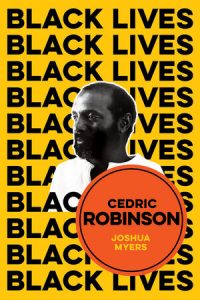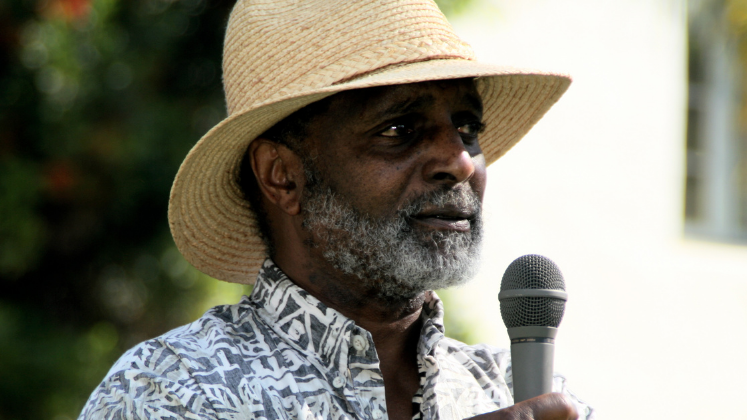Book Review: Cedric Robinson: The Time of the Black Radical Tradition by Joshua Myers

[ad_1]
In Cedric Robinson: The Time of the Black Radical Custom, Joshua Myers explores the practices of organising black resistance and unpacking the complicated forces that form black life by way of an examination of the life, works and legacies of Cedric Robinson. The ebook provides invaluable perception into understanding the person behind the idea of ‘racial capitalism’ and expresses hope at re-igniting how we view black resistance within the modern, writes Nyrema Baptiste.
Cedric Robinson: The Time of the Black Radical Custom. Joshua Myers. Polity. 2021.
 Black liberation in america is taught in snapshot segments, forcing the present activist-scholar to gaze upon actions just like the civil rights motion or the black energy motion as figments that existed at that second for in style tradition. This makes liberation look hollowed out, flattened and violent in its subjugation to the slim lens of what anti-blackness imagines resistance to its existence means in its cultural material. Subsequently, as we transfer ahead in what black liberation seems to be like for our present social equality actions like Black Lives Matter, we should additionally perceive the clear ideological framework of the previous that’s romanticised virtually to the purpose of erasure. As we fictionalise slain leaders and people who managed to flee from racial, colonial violence, we’re left with fragments of their recollections. Recollections that they’ve engraved into the bottom and, if we glance deep sufficient previous the present fictitious id of blackness within the US, into us as properly.
Black liberation in america is taught in snapshot segments, forcing the present activist-scholar to gaze upon actions just like the civil rights motion or the black energy motion as figments that existed at that second for in style tradition. This makes liberation look hollowed out, flattened and violent in its subjugation to the slim lens of what anti-blackness imagines resistance to its existence means in its cultural material. Subsequently, as we transfer ahead in what black liberation seems to be like for our present social equality actions like Black Lives Matter, we should additionally perceive the clear ideological framework of the previous that’s romanticised virtually to the purpose of erasure. As we fictionalise slain leaders and people who managed to flee from racial, colonial violence, we’re left with fragments of their recollections. Recollections that they’ve engraved into the bottom and, if we glance deep sufficient previous the present fictitious id of blackness within the US, into us as properly.
All the pieces black activists, students, organisers are navigating as we speak has been navigated earlier than by sensible thinkers who dug into their private black lives for remembrance, inspiration and power to grasp and transfer ahead in shaping black liberation within the US. Dr Cedric Robinson was a type of thinkers. Studying from numerous African leaders, brushing shoulders with minds like Walter Rodney and advocating for Malcolm X to speak on his college campus, Robinson embraced the historical past of black life, critiqued it and fashioned his understanding by unravelling what’s perceived as the entire image of black historical past within the US. From Robinson’s understanding, to be in resistance means to dig deeper than surface-level historical past and to think about the incompleteness of black life as our histories are gathered to turn into myths. So, if Robinson labored on strategically decentring the colonial push to make black liberation and black life mythological, then Joshua Myers’s new book sees Robinson as a visionary whose work is rooted within the expression of what makes black resistance doable.
In Black Marxism: The Making of the Radical Black Tradition (1983), considered one of Robinson’s most well-known works, he stresses that ‘as a scholar it was by no means my objective to exhaust the topic, solely to counsel that it was there’. This topic is the origins of resistance to Western modernity and its shaping of black family tree. So why are we taken on a historic family tree of black life when the dialog of this ebook is wrapped round black resistance? In Cedric Robinson: The Time of the Black Radical Custom, Myers, Professor of Africana Research at Howard College and creator of a recent history of the Howard University protests of 1989, tells us that it’s to demystify our snapshot view of resistance. Theoretically resistance is sort of a language in the best way blackness is. How we view black American historical past makes our present political language and tradition of resistance incomplete.

Picture Credit score: Crop of ‘np_rally_34.JPG’ by Doc Searls licensed below CC BY SA 2.0
Producing a concise ebook that acts as a basis for demystifying Robinson and difficult how we view historic liberation organisations and actions, Myers introduces how black resistance is rooted in black life and the efficiency of lively neighborhood participation out and in of academia. Moreover, we’re launched to Robinson’s different works and the circumstances of black life that formed his dedication to neighborhood and fashioned what made and makes the black radical custom.
Myers’s transfer to demystify Robinson and his work proves to be an insightful problem as he familiarises the reader with Robinson’s familial upbringing and attracts out the way it formed the crafting of the black radical custom. Within the first chapter, Robinson is launched to us by an antidotal retelling of his household’s ancestral migration from Cellular, Alabama, to California. It’s the story of many black households leaving, if doable, cities and areas so anti-black that even having a big black inhabitants did nothing to negate the racial violence enforced in on a regular basis life. From this story, we start to grasp Robinson and his attachments to resistance and neighborhood, which Myers additionally engages by way of Robinson’s early work, Black Movements in America. Myers analyses this textual content firstly of the primary chapter, placing into movement the lineage of mass black political motion by way of the migration of black people from the South and midwestern states, additionally documented in Isabel Wilkerson’s The Warmth of Other Suns.
What’s conceptualised right here is that we don’t actually perceive how the lives of our households form our political consciousness. The way in which Robinson particulars his household’s resistance in leaving Alabama is commonly the truth of how anti-blackness buildings our society and gives a response to the specter of loss of life imposed by anti-blackness. That’s what number of have formed their approach of addressing the scenario of oppression and resistance: the best way they bear in mind and communicate on it highlights how significant these conversations are in understanding the roots of their circumstances and the way they organised round it. ‘Throughout him had been these individuals, his individuals. They know life, Black being, had required wrestle’ (16). Myer’s evaluation of Robinson isn’t a surprise, contemplating the mapping Robinson undertook in Black Marxism to assist us think about a radical future rooted in understanding our historical past. In some ways, the primary chapter of Myers’s ebook units up the theme of unlearning the whole lot we learn about resistance, in regards to the figures and icons we’re allowed to acknowledge, shifting past the capitalist promoting of it and reconfiguring what animates the spirit of the motion.
Making sense of those circumstances is important to understanding Robinson’s work as an organiser as a result of black liberation can’t merely be theorised: the solutions which are sought won’t be readily present in texts that will alienate these they goal to have interaction. Myers touches on this as one other theme all through the ebook, centring Robinson’s concentrate on the practices of existence and liberation outdoors of Eurocentric political traditions, moderately than simply the idea of racial capitalism, which Robinson spent a chapter on in Black Marxism.
Myers connects Robinson’s experiences and wishes to the traditions inside black in style tradition as strategic ways envisioning and difficult misconceptions. In Chapter Six, ‘Tradition and Conflict’, Myers briefly utilises Robinson’s Forgeries of Memory and Meaning and descriptions its affect on black movie research, connecting it to as we speak’s black resistance actions. Robinson’s ebook broadens the dialog on what’s gained and misplaced within the shaping and reshaping of black political aesthetics, particularly within the media, as patterns type in understanding racial violence, resistance and the upkeep of black contentment. ‘Black movie exists solely within the underground, its creation a subversive act. Whiteness because the grounds for copy of the American movie trade has survived the modern cries for Black visibility and variety’ (Robinson quoted on web page 228). What, then, if the facility maintained is anti-black? How can we perceive how the previous has been formed by modernisation, even by way of the favored content material that’s digested by the lots?
Numerous questions stay to be engaged in Robinson’s work; nevertheless, extra readability on black life generates a framework that may show the restrictions of previous actions and our romanticisation of them. Anti-blackness is a systemic situation on the planet; it’s rooted up to now few centuries, and alongside it’s a legacy of resistance shadowing it and being redefined. The tip of Cedric Robinson: The Making of the Black Radical Custom finds a altering of the foundations of resistance organisation and the way we body our understanding of shifting ahead in direction of black liberation and the standard of black life in america. Nonetheless, for me, this ebook positions itself as a information by way of Robinson’s life and thru the struggles of lively resistance, which aren’t as clear-cut as particular episodes on tv, movies or black-and-white pictures counsel, given the lived actuality of black people world wide.
Cedric Robinson: The Making of the Black Radical Custom in the end seeks to encourage religion in black liberation, by way of a black historic family tree of a black chief whose work handled resistance to oppression. It assembles a mixture of familiarity, individuality and togetherness woven into the lived expertise of being black in Western society. Myers’s ebook grieves the person and his work however additionally it is uplifting, considering how a lot Cedric Robinson has helped to form the political panorama of black American life whereas additionally bringing into consciousness how little issues have modified.
Please read our comments policy before commenting.
Be aware: This text offers the views of the creator, and never the place of USAPP – American Politics and Coverage, nor of the London Faculty of Economics.
Shortened URL for this publish: https://bit.ly/3JnQEaT
Concerning the reviewer
Nyrema Baptiste – College of Edinburgh
Nyrema Baptiste is a PhD pupil on the College of Edinburgh. She accomplished an MA in Worldwide Affairs concentrating on Media and Tradition on the New Faculty. Her doctoral analysis centres round anti-blackness as a colonial construction inside black in style tradition. Particularly, she focuses on how anti-black classism has reshaped black resistance in black pop-cultural areas.
[ad_2]
Source link